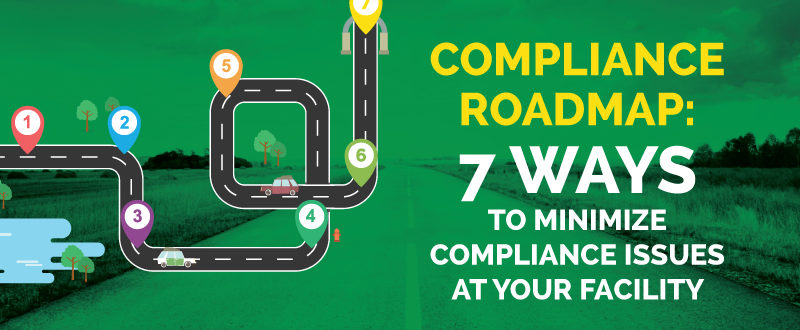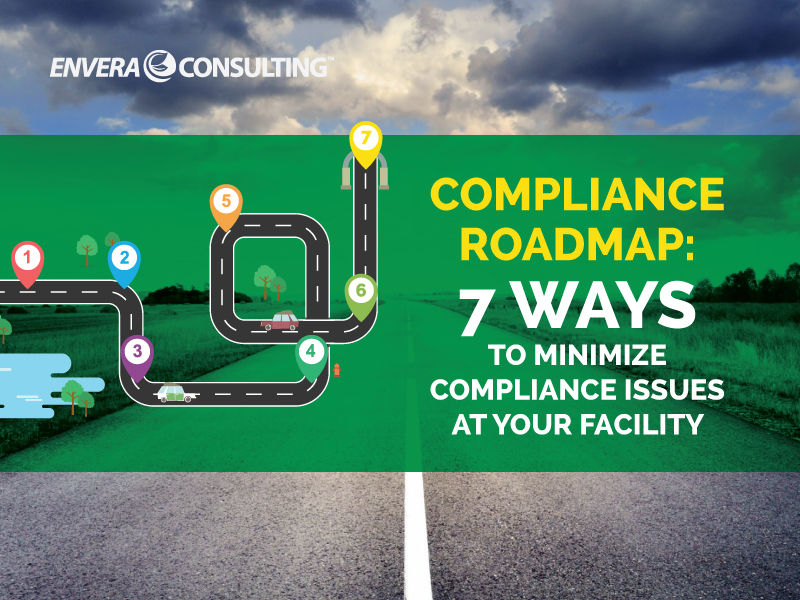

Non-compliance can mean the difference between success and failure at your business. Yet, some facilities have problems all the time, while some seem to run virtually problem-free.
Why is that?
Before I answer, let me ask you one question:
With the amount of publicly available data on your facility, can you really afford to have compliance issues?
Non-compliance adds unnecessary risk to your business and can irreversibly damage your brand, reputation, and financial success.
Over the many years that our staff has managed environmental affairs, both as a consultant and in the corporate setting, we’ve come up with a multi-pronged approach to successfully manage environmental compliance programs. And, to go back to the original question, we’ve found that the key differentiators between having and not having compliance issues are:
- understanding the “big picture”
- the development and implementation of a system to achieve compliance
That’s where Envera’s super-duper Compliance Roadmap comes in.
The Roadmap offers:
- a systematic way to understand environmental regulations
- a method of building compliance into the day-to-day workings of your business
- a way to build rapport with the regulators in order to reduce exposure and environmental risk — not to mention stress on yourself
The Roadmap is not a magic bullet. Not only does it not make smoothies, but it requires sweat equity — it’s gonna take some work on your part. But the Roadmap will help with how you approach the obstacles on the rocky road to compliance. I like to think that the Roadmap makes that road a little less bumpy.
Let’s go through the seven areas of the framework, which just so happen to be the seven ways facilities avoid environmental compliance issues.
1. Understand How Your Business Operations Impact the Environment
The first step is to ask yourself the following questions about your business operations:
- Do you emit air pollutants?
- Do you discharge water pollutants?
- Do you generate hazardous wastes?
- Do you have stormwater run-off from your property?
- Do you have contaminated groundwater under your property?
The impacts of an industrial facility affect several environmental mediums (air, water, and soil/land). Knowing how your business impacts the environment can greatly help you to understand which regulations apply to your business and, more importantly, why they apply.
2. Understand Which Regulations Affect Your Business
Today’s regulatory landscape contains so many different types of regulations that it can send you into a tailspin. Some regulations will pertain to you, and others not. Some will apply but, at the same time, you’ll be exempt.
Regardless, it is your responsibility to know which rules do or don’t apply to your business.
To do that, ask yourself:
- What are the environmental impacts of this new operation?
- Who are the agencies involved in regulating the impact?
- What are the federal acts/laws regulating this impact?
In determining which regulations may potentially apply, we recommend starting with the EPA’s Regulatory Information By Sector, which also breaks down the data by medium.
And then there’s our Spur-and-Slide Technique, our way of quickly skimming the chaos of SCAQMD rules to find those that apply to you.
3. Develop a Practical Approach to Achieve and Maintain Compliance
Sometimes a compliance headache starts with a poorly worded or inappropriate permit condition. Other times, the headache stems from being unaware or misunderstanding a specific rule or regulation.
To deal with the first example, read our post “3 Best Practices for Permit Conditions.” When it comes to the second example, we consider it a best practice to train your staff (e.g., maintenance and operations) on the compliance requirements of permit conditions or rule requirements. That’s because regulations can impact specific work practices that are carried out by laborers and other line staff, so you need to clearly communicate why things need to be done in a certain way (not just because you say so).
In all cases, company-wide ownership is key to the success of a practical compliance program. Folks from all levels of the organization should be working together to achieve the same goal: compliance. Reward folks who go above and beyond to ensure compliance, and train employees to make good compliance decisions.
And be sure you’re up to speed on what’s really happening on the front line and not just relying on word-of-mouth. Because a lot of time, what people say is being done isn’t what’s really being done. So when something goes wrong, you could be in for a very unpleasant surprise.
Ultimately, if compliance cannot be achieved in a practical manner, it may be a sign that a change is needed somewhere in the process.
4. Submit Your Reports on Time
This one should go without saying, but we’re always surprised when we learn that facilities have submitted their reports late — or failed to submit them all together. Seriously, it happens more often than you’d think.
One of the quickest ways to measure your facility’s environmental performance is to determine the percentage of environmental reports that were either submitted late or not at all. You’re not just doing this for your own self-enlightenment. Regulatory agencies can determine this percentage on their own and will take that into consideration when dealing with your facility. So it’s good to know your standing with them before you have any interactions.
Want to stay on top of your reporting calendar? Check out bullet #6 in our post “19 Ways Common Environmental Compliance Problems Start.”
5. Be Active in the Rulemaking Process
The rulemaking process is a great way to address the problematic portions of a specific regulation, particularly if they negatively affect your business. Rules are constantly being updated to include new pollution control technologies and types of equipment or to implement state pollution-control plans.
Rulemaking activities tend to be posted on the websites of regulatory agencies and are almost always open to the public. For the SCAQMD, rule-making activities can be found on their “Proposed Rules and Proposed Amended Rules” page.
6. Maintain a Good Relationship With Your Regulatory Agency
Communication is the key to any successful relationship. If you intend to remain in business, you need to work with the regulatory agency as best as possible. They have no intention of going away anytime soon.
If you’re having problems with or are unclear about a particular regulation, you should discuss it with your inspector or permit engineer right away. Part of communication includes ensuring that your reports are as clear and accurate as possible, containing enough supporting detail to answer all questions related to anomalies. As with most situations, unaddressed compliance problems tend to grow exponentially the more time passes.
7. Build Continuous Improvement Into Your Program
We’ve never had someone in the environmental department tell us “Our system is perfect” or “There is no room for improvement.” And that’s because there’s always room for improvement.
However, we may not always have the time to be proactive about improvement efforts. One of the benefits of having a compliance calendar (see point #4 above) is to know when the slower periods of the year are so you can take advantage of the “extra” time to be proactive and work on improvement efforts.
So instead of leaving compliance up to chance — which could mean having your business assume unnecessary environmental risk — use the Integrated Compliance Roadmap to successfully manage your environmental program.
Looking for More Compliance Help?
We have a variety of resources to help lower risk and improve compliance. Take a look at the following pages for more information about the regulations that affect your facility: